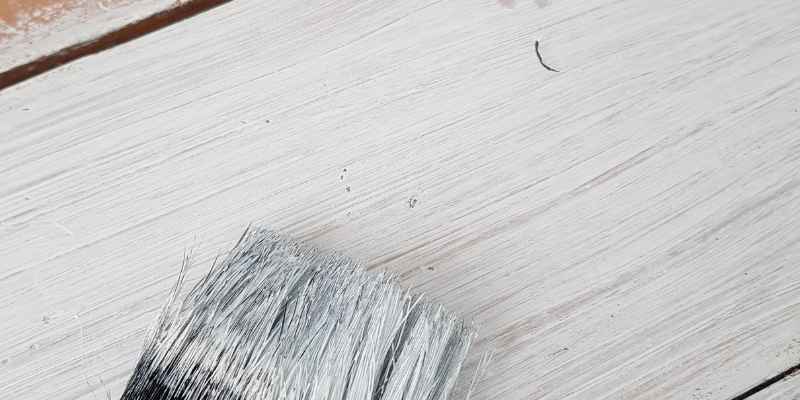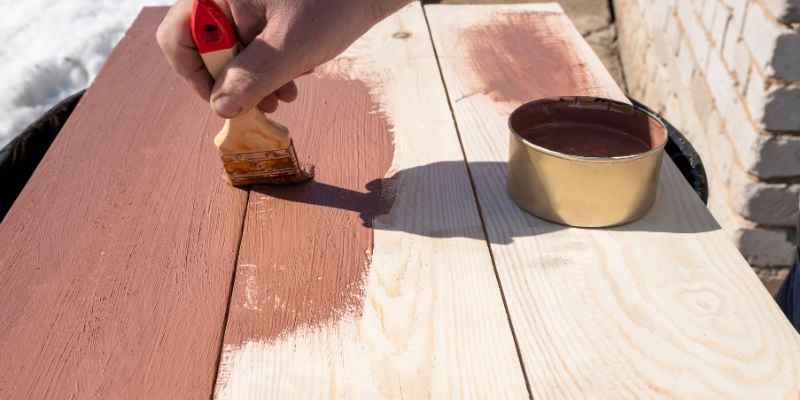Yes, you can paint over stained wood.
Understanding Stained Wood
In the world of interior design and home improvement, stained wood is a popular choice for many. It adds an element of warmth and character to any space. But what exactly is stained wood? How can you paint over it? Let’s dive into the details.
What Is Stained Wood?
Stained wood refers to wooden surfaces that have been treated with a stain, a type of coloring agent that penetrates deep into the wood, enhancing its natural beauty and providing protection against wear and tear. Unlike paint, which sits on top of the surface, stains seep into the wood to reveal its intricate grain patterns.
Benefits And Drawbacks
Stained wood offers several benefits that make it a popular choice among homeowners. Firstly, it brings out the natural beauty of wood, highlighting its unique characteristics. Stains also provide protection against moisture, sunlight, and everyday use, making the wood more durable and long-lasting.
However, there are a few drawbacks to consider. Stain colors can be limited, especially when compared to the vast color palette of paint. Additionally, stains may require more frequent touch-ups or refinishing compared to painted surfaces. It’s important to weigh these factors when deciding whether to paint over stained wood.
Common Types Of Stain
When it comes to selecting a stain for your wood, there are various options available. Some common types of stain include:
| Type of Stain | Description |
|---|---|
| Gel stain | A thick, gel-like stain that doesn’t drip or run, making it great for vertical surfaces and intricate detail work. |
| Oil-based stain | A traditional stain that delivers rich, deep colors and penetrates well into the wood. It requires longer drying times. |
| Water-based stain | A more environmentally-friendly option that dries quickly and has a low odor. It may not penetrate the wood as deeply as oil-based stain. |
Understanding the different types of stain can help you choose the most suitable one for your project.
Painting over stained wood can be a viable option if you want to change the look of your furniture or cabinetry. By understanding what stained wood is, weighing its benefits and drawbacks, and knowing the common types of stain available, you can make an informed decision on whether painting over stained wood is the right choice for your home.

Challenges Of Painting Over Stained Wood
When it comes to updating the look of stained wood, many homeowners consider painting as an option. However, this process is not without its challenges. Painting over stained wood requires careful consideration and preparation to ensure a successful outcome. In this section, we will explore some of the main challenges you may encounter when attempting to paint over stained wood and how to overcome them.
Adhesion Issues
One of the primary challenges when painting over stained wood is achieving proper adhesion. Stain penetrates the wood fibers, leaving behind oils and residue that can interfere with paint adhesion. This can result in paint peeling, chipping, or not adhering properly to the stained surface.
To overcome adhesion issues, it is crucial to properly prepare the wood surface before painting. Here are a few steps you can take:
- Start by thoroughly cleaning the stained wood to remove any dirt, dust, or greasy residue. A mild detergent and water solution can be used for this purpose.
- Sand the surface lightly to roughen it up and provide a better grip for the paint. Use medium-grit sandpaper and sand in the direction of the wood’s grain.
- Apply a high-quality primer designed for use on stained wood. The primer will create a bonding layer between the stained surface and the paint, enhancing adhesion.
Color Compatibility
Another challenge when painting over stained wood is ensuring color compatibility. Stains come in various shades, and the pigment can affect how the paint color appears on the wood surface. Additionally, certain wood species may have natural undertones that can alter the final paint color.
To address color compatibility challenges, it is recommended to:
- Select a paint color that complements or covers the existing stain color. Consider using a paint sample or swatch to test the color on a small area of the stained wood before applying it to the entire surface.
- If you desire a lighter paint color, choose a paint with good coverage and possibly one that includes a stain-blocking primer to prevent the original stain color from bleeding through.
- For darker paint colors, consider applying multiple coats for better coverage and to achieve the desired depth of color.
Preparation Requirements
When painting over stained wood, proper surface preparation is crucial for a successful outcome. In addition to addressing adhesion issues and color compatibility, there are other preparation requirements to ensure a smooth and long-lasting finish.
Here are some important steps to follow:
- Inspect the stained wood for any damages or flaws. Repair any cracks, holes, or imperfections using a suitable wood filler.
- Remove any hardware or fixtures that could obstruct the painting process. Mask off areas that you do not want to be painted, such as trims or windows, using painter’s tape.
- Use a high-quality paintbrush or roller suitable for the type of paint you are using to achieve a smooth and even application.
- Allow sufficient drying time between coats of paint to ensure proper bonding and prevent the paint from peeling or cracking.
- Apply a protective finish, such as varnish or polyurethane, over the painted surface to enhance durability and protect against wear and tear.
By following these preparation requirements, you can overcome many of the challenges associated with painting over stained wood and achieve a beautiful and long-lasting finish that transforms the appearance of your wood surfaces.
Steps To Paint Over Stained Wood
In this section, we will discuss the steps involved in successfully painting over stained wood. By following these steps, you can transform the look of your stained wood furniture or surfaces and give them a fresh, new appearance. Let’s get started!
Surface Preparation
Before you begin painting, it’s crucial to prepare the surface properly. This helps to ensure that the paint adheres well and provides a smooth, even finish. Here’s what you need to do:
- Clean the wood surface using a mild detergent or wood cleaner. Remove any dirt, dust, or grease thoroughly.
- Inspect the wood for any damages like cracks, holes, or chips. Fill these imperfections with wood filler and sand them smooth after it dries.
- Scuff the stained surface using fine-grit sandpaper. This step helps to remove the glossy finish and create a slightly rough texture for better paint adhesion.
- Using a damp cloth, wipe away any dust or residue left from sanding. Let the wood surface dry completely before moving to the next step.
Choosing The Right Paint
When it comes to painting over stained wood, selecting the right paint is crucial for a successful outcome. You’ll want to choose a paint that is specifically designed for wood surfaces and provides good coverage. Keep these points in mind:
- Consider the type of wood you are painting. Different types may require different types of paint, such as latex or oil-based.
- Choose a paint color that complements your desired aesthetic. Remember to consider the overall theme and color scheme of the room or space where the painted wood will be placed.
- Opt for a high-quality paint that offers good durability and is easy to clean, especially for surfaces that may experience a lot of wear and tear.
Priming The Wood
Priming the stained wood before applying the paint is highly recommended, especially if you want a smooth and long-lasting finish. Here’s why and how:
Priming helps to:
- Seal the stained surface and prevent any bleed-through or discoloration from the wood.
- Promote enhanced adhesion of the paint and provide a suitable surface for an even finish.
- Improve the longevity and durability of the painted wood by creating a protective barrier.
To prime the wood:
- Select a high-quality primer that is specifically designed for wood surfaces.
- Apply the primer using a brush or a roller, ensuring even coverage.
- Allow the primer to dry completely as per the manufacturer’s instructions before proceeding to the next step.
Applying The Paint
Now that your surface is prepared and primed, it’s time to apply the paint. Follow these steps to achieve a professional-looking finish:
- Stir the paint thoroughly to ensure an even consistency throughout.
- Apply the paint using a brush or roller, moving in the direction of the wood grain.
- Make sure to apply the paint evenly and avoid excessive buildup or drips.
- Allow the first coat to dry completely, and if necessary, apply additional coats for better coverage.
- After the final coat, allow the paint to dry fully before using or placing any objects on the painted surface.
By following these steps and paying attention to detail, you can easily paint over stained wood and achieve impressive results. Remember to work in a well-ventilated area and protect surrounding surfaces as necessary. Happy painting!

Tips And Tricks
When it comes to transforming the look of stained wood, painting can be a fantastic solution. Whether you want to update the color or give it a fresh, new appearance, painting over stained wood can bring a whole new life to your furniture or surfaces. In this section, we will explore some essential tips and tricks to help you successfully paint over stained wood.
Testing The Paint
Before diving into the painting process, it’s crucial to test the paint on a small, inconspicuous area of the stained wood. This step ensures compatibility, adhesion, and allows you to determine the number of coats required. Use a brush or a roller to apply a thin layer of paint and let it dry completely. Additionally, check for any undesired reactions or discoloration. Once satisfied, you can confidently proceed with painting the rest of the stained wood.
Using A Sprayer Vs. Brush
When it comes to applying paint over stained wood, you have options – using a sprayer or a brush. While both methods can yield great results, they come with their own pros and cons. A sprayer provides faster and more even coverage, especially for large areas. On the other hand, a brush gives you more control and precision, making it ideal for detailed work or smaller surfaces. Consider the size of the project, your personal preference, and the finish you desire when choosing between a sprayer and a brush.
Avoiding Common Mistakes
When painting over stained wood, it’s important to be mindful of potential mistakes that can hinder your final results. To ensure a smooth and successful process, avoid the following common errors:
| Using low-quality paint: | Invest in high-quality paint to achieve better coverage, durability, and a professional finish. |
| Not sanding properly: | Thoroughly sand the stained wood surface to remove any existing finish, providing a smooth base for the paint to adhere to. |
| Skipping primer: | Applying a suitable primer ensures better adhesion and helps prevent any possible bleed-through of the previous stain. |
| Rushing the drying process: | Follow the manufacturer’s instructions regarding drying time between coats to achieve optimal results. |
| Not using a sealant: | To protect your newly painted surface and prolong its lifespan, consider applying a clear top coat or sealant. |
By avoiding these common mistakes and following the appropriate steps, you can achieve a beautiful and long-lasting transformation when painting over stained wood.
Conclusion
To conclude, painting over stained wood is indeed possible and can be a great way to refresh your furniture or woodwork. By following the right steps and using the appropriate materials, you can achieve a beautiful and durable finish. Remember to properly prepare the wood surface, choose the right primer and paint, and apply multiple thin coats for the best results.
So go ahead and transform your stained wood into something new and vibrant with a fresh coat of paint!


